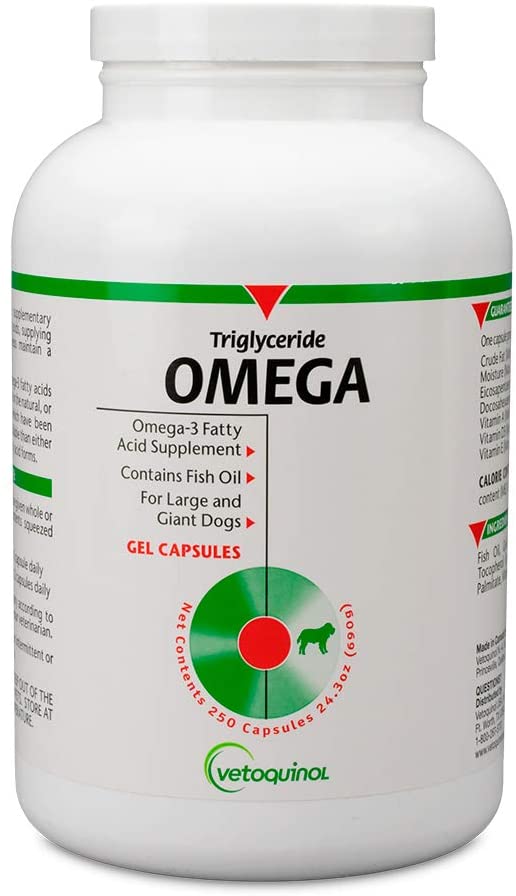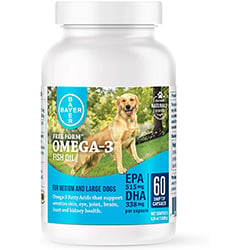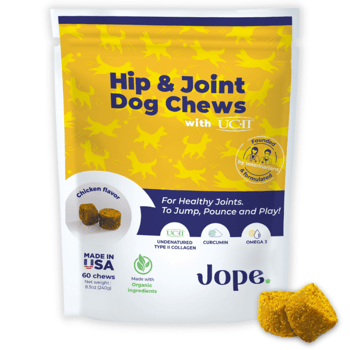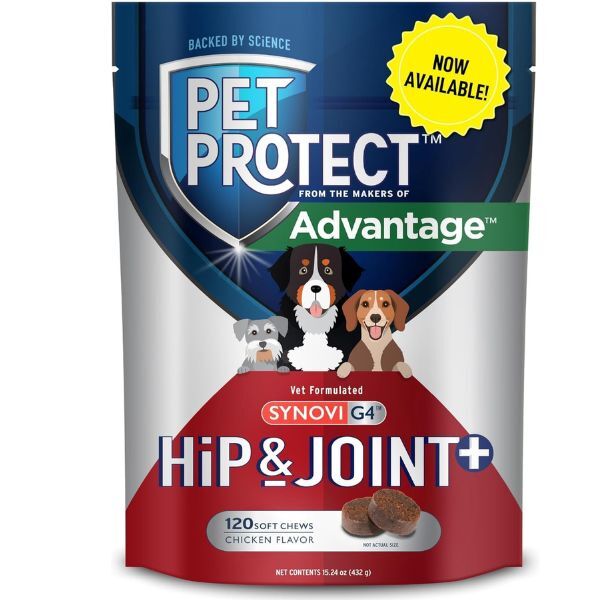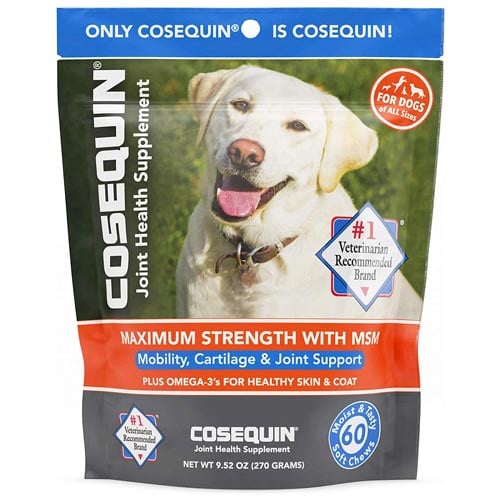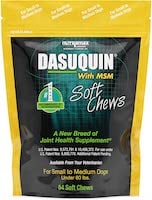 When you have a young dog, you may not be thinking about arthritis, as it’s often thought of as a senior dog or large breed problem.
When you have a young dog, you may not be thinking about arthritis, as it’s often thought of as a senior dog or large breed problem.
Unfortunately, that couldn’t be further from the truth! Any age and breed of dog can suffer from arthritis.
Derailing or slowing down the effects of arthritis should be considered as early as puppyhood.
You'll want to limit certain activities, manage your young dog's weight, and consider giving them supplements. Read on for all the things to consider to help your dog avoid the lifelong effects of arthritis.
Ways to Slow Down Arthritis
(Quick Links):
Regardless of breed size (large or small), 25% of dogs older than one year of age have arthritis. And that increases to 50% once they’re between 5 and 10 years of age.
Arthritis Can't Be Reversed, But It Can Be 'Prevented'
The disease goes by many names: Degenerative Joint Disease (DJD), Osteoarthritis (OA), Arthrosis, or Arthritis, but in the end, we are all discussing the same health issue.
Arthritis is a progressively deteriorating process affecting the entire joint. A joint includes the joint capsule, the bone, the cartilage, the joint fluid, the ligaments, the tendons, the muscles, and the nervous system.
In a healthy canine joint, the cartilage and synovial fluid act as a cushion to allow a joint to move smoothly in a full range of motion with the support of the surrounding capsule, ligaments, and muscles. In an arthritic joint, that cushion is worn down, the joint capsule is damaged, and nerves are affected, which results in pain, inflammation, and decreased mobility.
Once the effects of arthritis have taken effect, all you can do is help it not progress or cause your dog any additional pain – but you can't repair the damage it's caused.
While we'd love to say that arthritis can be prevented, we really can't because one of the most significant causes of arthritis is inflammation, and inflammation can occur anywhere in the body for many reasons, such as trauma, illness, etc. Often, inflammation can be present in a dog’s body, and we don’t even know it's happening or the effects it's having. You can slow it down a great deal, though, with the recommendations below.
Which Dogs Are More Likely to Get Arthritis?
Any dog of any age is susceptible to the condition. However, obese dogs, athletic dogs who perform repetitive actions (running, jumping), and those with conformational issues (bowlegged), pelvic deformities, and luxating patellas (knee caps), such as bulldogs and Chihuahuas, can be more predisposed to having arthritis.
While you can’t completely stop arthritis from happening, there are steps you can start taking right now to help slow its progression as well as prolong your dog’s pain–free active years.
If you have a mobility-challenged dog, check out our tips in this article.
Ways to Slow Down the Progression of Arthritis in Dogs
Manage Your Dog’s Weight
Fat cells are pro-inflammatory. So, just their presence is a constant low-grade cause of secondary inflammation in your dog’s body. Follow these principles to help keep your dog at an optimal weight:
Feed a balanced diet: Feed your puppy now and in the future a high-quality diet to ensure proper nutrition. If you are unsure of the best diet for your pet’s age, activity level, and breed, consult your veterinarian. NOTE: Large breed puppies need to be fed a commercially-produced large breed puppy food for the first year and then switched to adult large breed food. This helps prevent your puppy from growing too rapidly. Rapid growth spurts can lead to joint issues later in life.
Feed the right amount: Start smart by always correctly measuring your dog’s food with a measuring cup so that you create a good habit for yourself to prevent overfeeding now and also later in life. Obesity is a huge factor in the progression of arthritis. And yes, puppies can get obese! Read more in "How Much and How Often Should You Feed Your Dog?"
A pound is not just a pound: For example, a Chihuahua that is 1 pound overweight is like us gaining 33 lbs! A beagle gaining 5 pounds is like a human putting on 20 lbs. Pound on top of pound really adds up. It adds a significant amount of strain on not only your dog’s joints but also their spine. Arthritis can also develop in the spine. Arthritic changes to the spine can cause degeneration of the discs, leading to the possible development of intervertebral disc disease.
Human food: Do not start feeding your puppy table scraps or bits of your food. Human food is a huge contributing factor to obesity in pets. Also, it can cause gastrointestinal issues such as vomiting, diarrhea, and even pancreatitis.
Love and praise are better rewards: Monitor the type and number of treats you give your dog daily. Treats shouldn’t make up more than 10% of your dog’s daily calories. Tip: Use your dog’s regular food (kibble) as their reward, or just lavish them with love or a favorite toy or game of tug. Another great treat option is green beans (preferably the low-sodium kind if using canned beans).
Regular weigh-ins: After your puppy is finished with their puppy vaccine series, be sure to regularly weigh your pup — at least once a month. Keep a record of their weight so you know when they are gaining too much. Your veterinarian can guide you on what weight is best for them. You can also check your dog against this body condition score chart. Always think hourglass figure for your pup throughout their life!
Avoid Certain Activities
An excellent form of non-impact exercise for dogs is swimming or going for a walk. However, certain types of activities and exercise can cause or worsen the progression of arthritis.
- High-impact daily activity: It has been found in studies that it is best for puppies less than 3 months old not to use stairs or even walk on slippery surfaces. Also, don’t let your puppy get into the habit of jumping in and out of your vehicle, especially SUVs and trucks, until they’re fully grown. Teach your puppy from an early age not to jump on and off the bed or furniture. This can cause repetitive trauma to not only the joints but also to your dog’s spine. This can set your puppy up for developing arthritis later in life. Use ramps, or pick up your pup until they are about 3 months old. If your dog has the tendency to always leap off the stairs or deck, work to train them to use a ramp. Luring them with a treat (to follow their nose) can help.
- Appropriate exercise: Exercise is very important throughout your dog’s entire life. But it is very important to properly condition your pet for physical activities such as running or agility — in other words, go slow. It is also critical not to allow them to overdo it while exercising. Poor conditioning and fatigue can lead to inflammation in your dog’s body. It is best not to take your dog running or do any high-impact exercise until they are 18 months to 2 years old.
- Avoid activities where your dog is leaping into the air: This is setting them up for trauma and is creating uneven weight loads and distribution on their joints. It has been studied that dogs that regularly chase fetch toys between the ages of 12 to 24 months have a higher risk of developing hip dysplasia. However, any time a dog of any age leaps into the air, there is a risk of trauma to a joint or their spine. If there are any underlying issues, injury can result. This type of activity places strain on the muscles, tendons, and ligaments, which can, in turn, create inflammation – the driving force of arthritis. Let your dog have fun, but moderation, close observation, and monitoring your dog's health with your veterinarian are key.

Start Giving Supplements
Start your dog on fish oil at about 1 year of age and a joint supplement by 2 years old – this is recommended even though you don’t see signs of arthritis.
Note: It is best to consult your veterinarian before starting a joint supplement – for their recommendation and to be sure it’s safe if your dog has any other health issues. Also, DO NOT give human joint supplements to dogs. They may contain harmful ingredients, and they may not contain the correct amount of each ingredient that is listed. Only use veterinary-formulated and recommended joint supplements.
Fish Oil
Fish oil is naturally anti-inflammatory, and it is excellent for your dog’s skin, which is a significant factor in helping with their immune system. You want to read labels and ingredient lists, as you don’t want fish oil products that have added Vitamin D, which can be toxic to pets. And some of them, oddly enough, have xylitol, the natural sugar substitute, which is highly toxic to dogs. To be extra safe, it’s best to stick with veterinary-formulated supplements. Below are some veterinary-recommended fish oil supplements. For more information about fish oils and their benefits, check out our fish oil article.
Veterinary-formulated fish oils for dogs
Joint Supplement
Joint supplements not only help protect the cartilage in your pet’s joints but also act as an anti-inflammatory. Here are ingredients you want to look for in a good joint supplement. I usually recommend starting with Glucosamine and MSM, and as your dog ages and possible symptoms arise, then you can find ones with more ingredients. I’ve listed a few supplements below to get you started.- Glucosamine – helps slow down collagen degradation and inhibit inflammation-producing factors.
- MSM (methylsulfonylmethane) – crucial for connective tissue and an excellent anti-inflammatory agent. It may also have hepatoprotective properties (protects the liver). Also, it helps with pain.
- Chondroitin Sulfate – acts as an anti-inflammatory agent and helps reduce the breakdown of collagen.
- Boswellia serrata – has good anti-inflammatory benefits.
- Superoxide dismutase – helps to scavenge molecules known to cause damage to tissues.
- Yucca schidigera – a potent antioxidant and anti-inflammatory agent.
- Undenatured Type II Collagen – this is the main structure of cartilage tissue. It has been reported to be more effective, even in small dosages, than glucosamine and chondroitin sulfate. It reduces joint inflammation, promotes cartilage repair, and protects against cartilage damage. Studies show it helps reduce lameness after general pain and pain with limb manipulation and eases the pain of arthritic dogs during physical exertion. See the Jope product below that has this as a main ingredient.
- Omega-3 – decreases pain, inflammation, and lameness associated with arthritis. Studies show that it helps improve weight-bearing functional activities. Read more about fish oil benefits.
- Curcumin – helps decrease pain, has an anti-inflammatory effect, acts as an antioxidant, and protects the cells of cartilage.
Veterinary-formulated joint supplements for dogs
Jope Hip & Joint Dog ChewsThese chews were developed by veterinarians who know first-hand how arthritis impacts our dogs’ lives. The ingredients used have been clinically shown to reduce pain and increase joint strength.
They contain undenatured type II collagen (UC-II), which has been shown to be more effective (even in small dosages) than glucosamine and chondroitin sulfate with regard to the management of arthritis.
I personally use undenatured type II collagen, and it has been truly beneficial to my joints.
A second important ingredient that these chews contain is high amounts (4x leading brands) of Omega-3. Read more about all the benefits of fish oil in this article.
The last ingredient (and one I can personally support as well) is curcumin. Curcumin helps decrease pain, has an anti-inflammatory effect, acts as an antioxidant, protects the cells of cartilage, and helps enhance the effects of the UC-II and Omega-3.
Jope chews are also meat allergy-friendly, made in the USA, and made with organic ingredients. They are also 100% satisfaction guaranteed – you can’t beat that!
Other Ways to Slow Down Arthritis
- At about 2 years of age, consult with your veterinarian about having your dog’s hips and stifles (knees) x-rayed. This will give you an indication if there is already evidence of arthritis. Later in life, if your pet is sedated for a procedure, like a dental cleaning, request x-rays of your dog’s spine, hips, and stifles so that you can keep track of their progress.
The purpose of having the hips x-rayed at 2 years is to evaluate for hip dysplasia. In general, if a dog older than 2 years old hasn't been diagnosed with hip dysplasia, they likely won't ever have it. However, there are things like genetic factors, traumatic injury, lack of muscle strength, or overloading the joint with too much weight that could cause hip dysplasia later on in life. So, keeping track of your dog's baseline with X-rays helps you monitor their progression and stay on top of any modifications in supplementation, diet, etc., that you could implement to help your dog.
If arthritis is detected, then this is when you must be strict about maintaining a diet for a lean body weight, preventing trauma or other causes of inflammation (no stairs or long runs), and supporting the immune system with supplements, etc.
Arthritis is a slow and progressive disease, but knowing it is there helps you take precautions, and if you haven’t been working on methods to help pretreat since your dog wasn't showing signs of arthritis, then you can start now! This is when I would definitely recommend using a joint supplement with more ingredients than just MSM and Glucosamine. Canine massage also helps keep muscles limber and increases flexibility, and acupuncture has many benefits. - Keep your dog on effective flea and tick prevention, as well as heartworm prevention. Fleas can cause allergic reactions in some dogs, which in turn can cause inflammation in the body. If a tick is carrying a rickettsial disease (Lyme disease, for example), that can create significant joint issues. And if a dog gets heartworm disease, it produces significant trauma and inflammation to the heart and lungs. Remember, we want to do everything to avoid inflammation, so avoiding these parasites can help for this reason and many others.
- Use a harness and leash instead of a leash attached to a collar to walk your dog. This helps prevent trauma to your pet’s neck region if they pull. Pulling can cause inflammation of the muscles — a trigger for arthritis, and if arthritis is present in the cervical vertebrae, it is possible for Intervertebral disc disease (IVDD) to occur.
Good luck with these supportive measures. They are sure to help! If you suspect your dog may be developing arthritis, be sure to bring them to your veterinarian. Taking a few action steps early on will help give your amazing pet a longer life that is more active and pain-free.




